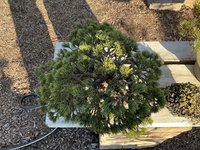Here’s a tree I bought from Plant City many years ago. They bought from a vendor at the California Shohin Convention, and that vendor had said Peter Tea had styled it. So, when I bought it, it had Peter’s cut paste all over the apex area. (Peter used Japanese wall paper paste as cut paste!). Unfortunately, it didn’t work, and the apex died out, so in later years, I’ve completely restyled the tree using a different front.
The pot is an antique Chinese pot that I purchased from Peter right after he returned from Japan after his apprentiship. So… I call it my “Peter Tea” tree, even though Peter did not make the pot, he did not put this this in this pot, and I have completely restyled it! Lol!!!

I had fun wiring. I did about half of it yesterday, and finished it up today.
This tree has unfortunate reverse taper right at the nebari soil line. This is common with these JWP grafts on JBP stock where they left the wire on to get embedded. The best I can do is build up some moss around the base when I want to show it.
The pot is an antique Chinese pot that I purchased from Peter right after he returned from Japan after his apprentiship. So… I call it my “Peter Tea” tree, even though Peter did not make the pot, he did not put this this in this pot, and I have completely restyled it! Lol!!!

I had fun wiring. I did about half of it yesterday, and finished it up today.
This tree has unfortunate reverse taper right at the nebari soil line. This is common with these JWP grafts on JBP stock where they left the wire on to get embedded. The best I can do is build up some moss around the base when I want to show it.

